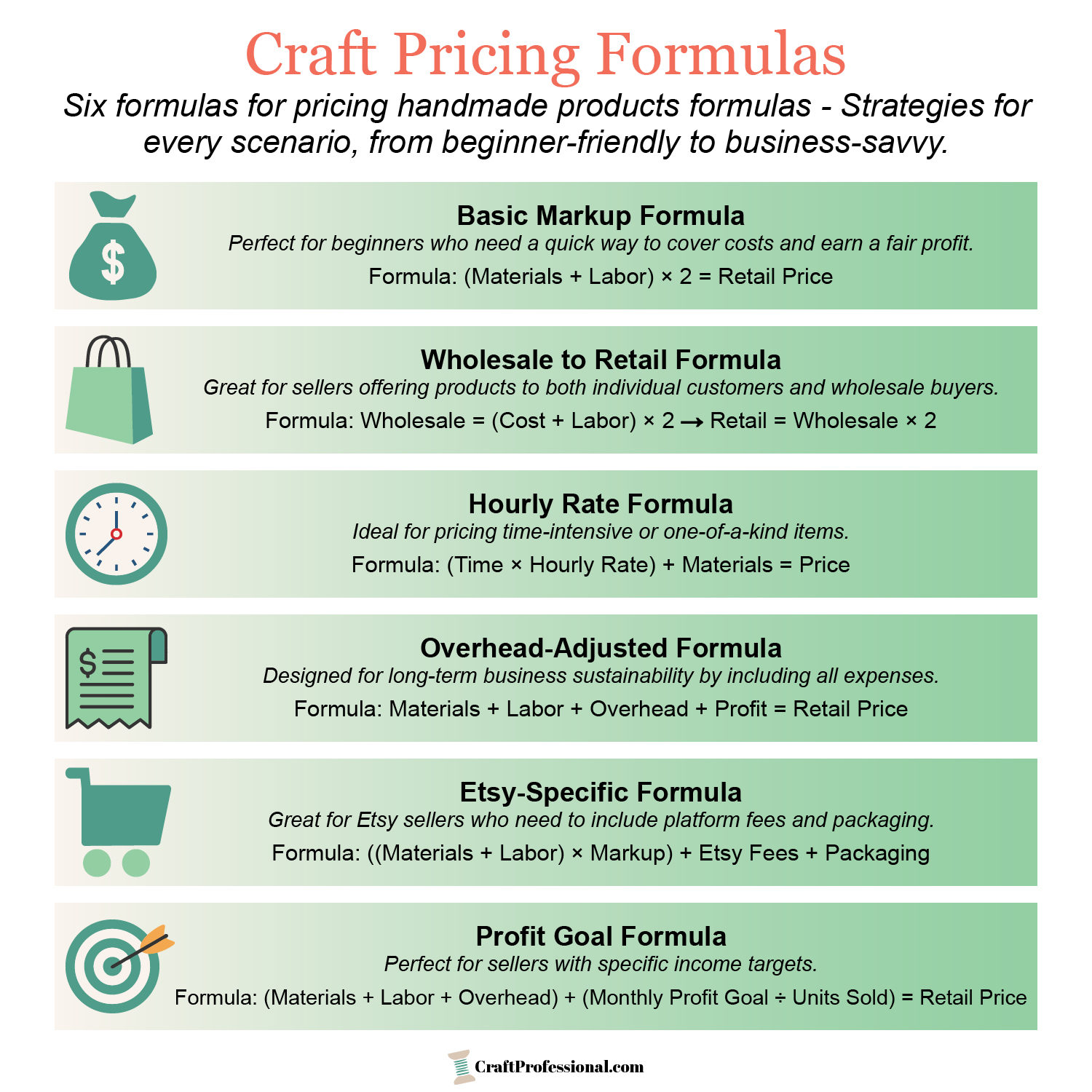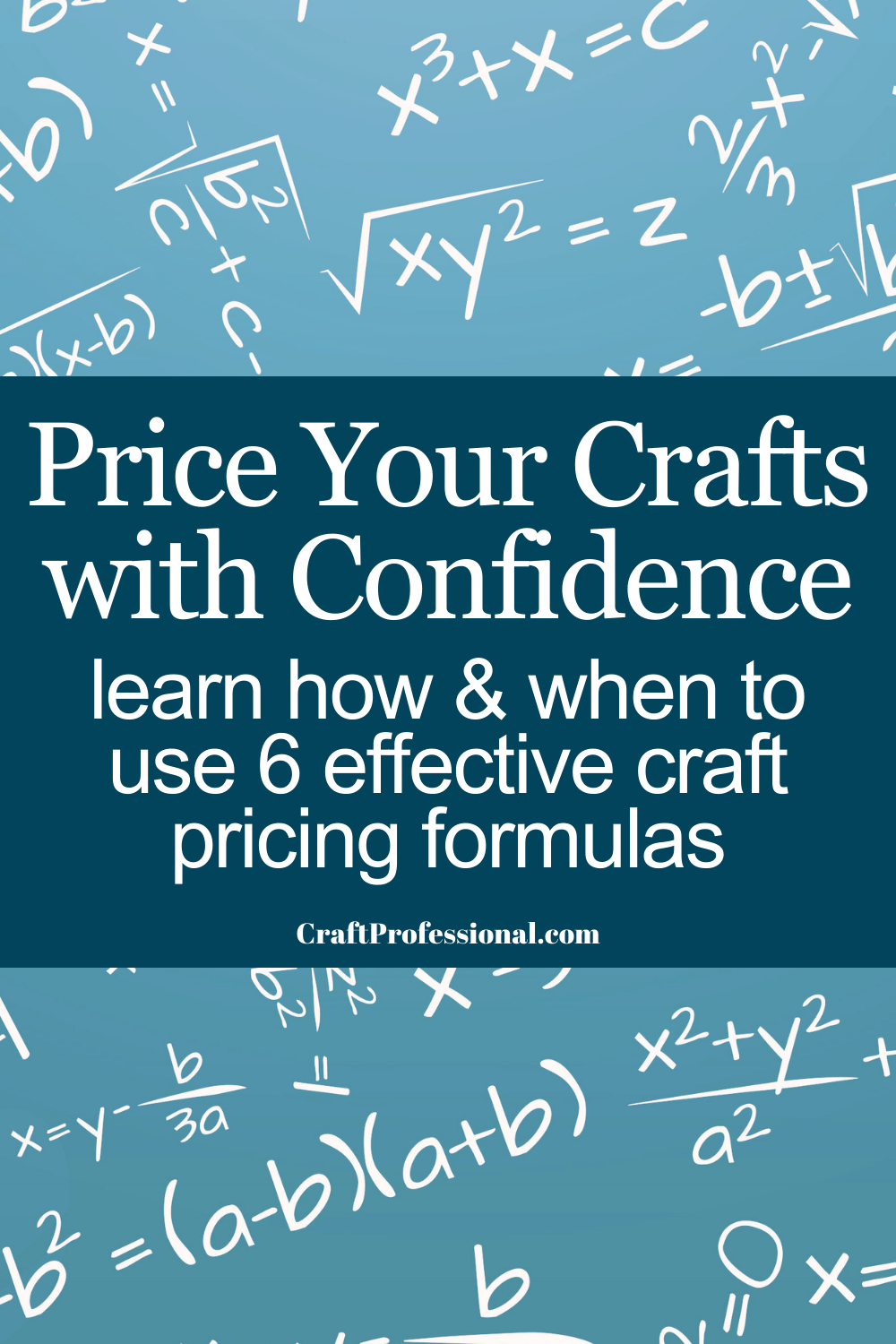- Home
- Craft Pricing
- Craft Pricing Formulas
Craft Pricing Formula: How to Price Your Handmade Goods for Profit
A craft pricing formula can take the guesswork out of deciding how much to charge for your handmade products.
This guide breaks down the most popular strategies, shows you how to apply them, and includes real examples to help you confidently charge what your work is truly worth.
Whether you sell on Etsy, at craft fairs, or through your own site, pricing your crafts properly is one of the trickiest, and most important, parts of running a handmade business.
Happily, you don't have to guess anymore! This guide guides you through popular craft pricing formulas. You'll get real-world examples and easy-to-use tools to make pricing simple and profitable.
Let's dive in!
What You'll Learn
Why Craft Pricing Strategy Matters: Why being strategic about pricing is critical to handmade business success.
Pricing Formula Overview: Quick snapshots of each formula with guidance on when to use them.
6 Popular Craft Pricing Formulas: Pricing formulas for every scenario, from beginner-friendly to business-savvy.
- Basic Markup Formula
- Wholesale to Retail Formula
- Hourly Rate Formula
- Overhead-Adjusted Formula
- Etsy-Specific Formula
- Profit Goal Formula
Which Craft Pricing Formula is Best for You? A comparison chart of all formulas, including the pros and cons of each formula and when to use each strategy.
Definitions of Essential Pricing Terms
Troubleshooting High Prices: How to evaluate and adjust your pricing if needed.
Why Craft Pricing Strategy Matters
Many new sellers estimate their prices like this:
I paid $10 for materials and spent 2 hours making it... maybe $30 is fair?
But they forget important realities:
- Your time is valuable
- Business expenses add up fast
- Marketplaces like Etsy charge fees
- You need to earn a profit, not just break even
That's why using a structured pricing method is essential. It removes uncertainty and helps you make fair, clear, and sustainable pricing decisions.
Pricing Formula Overview
There's no one-size-fits-all solution. The right method depends on:
- Your product type
- Your business goals
- Where and how you sell your crafts
To help you choose wisely, we outline six common pricing approaches, each with examples and links to matching online calculator to try out each formula.

6 Popular Craft Pricing Formulas (With Examples)

1. Basic Markup Formula
Perfect for beginners who need a quick way to cover costs and earn a fair profit.
Formula:
(Materials + Labor) × 2 = Retail Price
Best For:
Beginners and low-cost crafts
Example: Soy Candle
- Materials: $7.00
- Labor (30 mins at $15/hr): $7.50
- Retail Price: ($7 + $7.50) × 2 = $29.00
Try it: Basic Markup Calculator

2. Wholesale to Retail Formula
Great for sellers offering products to both individual customers and wholesale buyers.
Formula:
Wholesale = (Cost + Labor) × 2
Retail = Wholesale × 2
Best For:
Selling both retail and wholesale
Example: Canvas Tote Bag
- Materials + Labor: $30.00
- Wholesale = $60.00
- Retail = $120.00
Try it: Wholesale to Retail Calculator

3. Hourly Rate Formula
Ideal for pricing time-intensive or one-of-a-kind items.
Formula:
(Time × Hourly Rate) + Materials = Price
Best For:
Custom or time-intensive pieces
Example: Handmade Necklace
- 1.5 hours at $25/hr = $37.50
- Materials = $7.00
- Price: $44.50
Try it: Hourly Rate Calculator

4. Overhead-Adjusted Formula
Designed for long-term business sustainability by including all expenses.
Formula:
Materials + Labor + Overhead + Profit = Retail Price
Best For:
Full-time or serious sellers
Example: Digital Art Print
- Labor = $30
- Overhead = $2
- Profit = $10
- Price: $42.00
Try it: Overhead-Adjusted Calculator

5. Etsy-Specific Formula
Great for Etsy sellers who need to include platform fees and packaging.
Formula:
((Materials + Labor) × Markup) + Etsy Fees + Packaging
Best For:
Etsy and marketplace sellers
Example: Chunky Knit Blanket
- Base cost (materials + labor) = $65
- Markup × 2 = $130
- Fees + Packaging = $9
- Etsy Price: $139.00
Try it: Etsy-Specific Calculator

6. Profit Goal Formula
Perfect for sellers with specific income targets.
Formula:
(Materials + Labor + Overhead) + (Monthly Profit Goal ÷ Units Sold) = Retail Price
Best For:
Business-focused sellers with income targets
Example: Hand-Painted Mug
- Materials: $5.00
- Labor (1 hr at $20/hr): $20.00
- Overhead Allocation: $2.00
- Monthly Profit Goal: $1,000
- Units Sold per Month: 25
- Profit per Mug: $1,000 ÷ 25 = $40.00
- Retail Price: ($5 + $20 + $2) + $40 = $67.00
Try it: Profit Goal Calculator
Which Craft Pricing Formula Should I Use?
Not sure which formula is best for your business?
Use this comparison of the popular craft pricing formulas to help you choose the best pricing method for your handmade products.
If you'd like to view the full chart, click the "View Full Comparison Table" button below. This layout makes it easy to compare formulas based on complexity, use case, and how factors like overhead and profit are handled.
1. Basic Markup Formula
Formula: (Materials + Labor) × 2
Best For: Beginners, hobby sellers
Includes Overhead? No
Complexity: ⭐ (Very easy)
Pros:
– Super simple
– Works for most craft types
Cons:
– Doesn't cover overhead or platform fees
2. Wholesale/Retail Formula
Formula:
Wholesale = (Cost + Labor) × 2
Retail = Wholesale × 2
Best For: Sellers offering wholesale or scaling up
Includes Overhead? No
Complexity: ⭐⭐
Pros:
– Maintains consistent margins
– Prepares for business expansion
Cons:
– May inflate prices for low-cost goods
3. Hourly Rate Formula
Formula: (Time × Hourly Rate) + Materials
Best For: Custom work, time-intensive crafts
Includes Overhead? No
Complexity: ⭐⭐
Pros:
– Ensures you're paid for your time
– Good for handmade commissions
Cons:
– Ignores business overhead costs
4. Overhead-Adjusted Formula
Formula: (Materials + Labor) + (Overhead %) + Profit
Best For: Full-time sellers, small businesses
Includes Overhead? Yes
Complexity: ⭐⭐⭐
Pros:
– Covers real business expenses
– Helps ensure profitability
Cons:
– Requires tracking and calculations
– Slightly more complex
5. Etsy-Specific Formula
Formula: ((Materials + Labor) × Markup) + Etsy Fees + Packaging
Best For: Etsy sellers
Includes Overhead? Yes
Complexity: ⭐⭐
Pros:
– Accounts for Etsy's unique fees
– Designed for platform-specific selling
Cons:
– Less useful outside Etsy
– Markup must be fine-tuned
6. Profit Goal Formula
Formula: Total Costs + Desired Profit = Price
Best For: Business-focused sellers with income goals
Includes Overhead? Yes
Complexity: ⭐⭐⭐
Pros:
– Goal-oriented
– Supports business planning
Cons:
– Requires clarity on goals and expenses
Craft Pricing Definitions
To help you get the most out of each craft pricing formula, here are definitions of a few key concepts.
- Materials Cost: Includes items such as raw supplies, shipping materials, and packaging
- Labor Cost: Time spent × hourly rate
- Selling Expenses: Show fees, commissions, or platform charges
- Overhead: Tools, workspace, software, utilities; check out this list of common craft business expenses for more details
- Wholesale vs. Retail: Wholesale is typically 50% of retail price
- Market Price: What similar items sell for in your niche
Troubleshooting High Prices
If you enter your numbers into a pricing formula and the result seems way too high, don't panic! It's not time to under-charge for your products. It's time to dig deeper and troubleshoot the root cause.
1. Break Down the Price Components
Start by pinpointing what's driving the high number. Is it:
- High material costs?
- A lot of labor time?
- Big overhead expenses?
- An ambitious profit goal?
Understanding the makeup of the price helps you know where you have flexibility and room for improvement.
2. Can You Reduce Costs Without Cutting Quality?
Look for opportunities to reduce costs while keeping your product's quality intact.
- Reduce the cost of materials. Can you buy materials wholesale, or from a different supplier to get better rates?
- Streamline production. Look for ways to simplify your process.
- Track your time carefully. Look for places where you're less efficient than you could be.
Even small adjustments can lower your costs significantly over time.
3. Raise the Perceived Value
If you believe your product is worth the price but shoppers aren't buying, the issue may be perception. Ask yourself:
- Are your product photos high-quality and styled well?
- Does your branding feel professional and trustworthy?
- Is your product description highlighting the benefits and uniqueness?
Your goal is to show customers why your item is worth what you're charging.
4. Review Your Market Fit
Compare your pricing to others selling similar products. If you're priced higher:
- Are your materials or craftsmanship superior?
- Do you offer extras (like personalization or eco-friendly materials)?
- Are you targeting the right audience, one that values quality over price?
Sometimes, high pricing simply means you're in the wrong marketplace or not telling your story clearly enough.
5. Adjust the Formula Strategically
Your pricing formula is a tool, not a hard rule. You can:
- Set a lower profit goal while building your audience.
- Offer entry-level products at a lower price point to attract new buyers.
- Create bundle deals or tiered pricing options.
The key is to make adjustments that align with your goals without undervaluing your time or talent.
6. Get In-Depth Guidance
For expert tips on adding perceived value, check out How to Price Crafts and Things You Make to Sell by James Dillehay. It's packed with practical ideas about pricing your crafts for profit!FREE! Download Your Craft Pricing Formula Guide (PDF)
Get a printable 8.5" × 11" summary of:
- All six pricing formulas
- Real product examples
- A full side-by-side comparison chart
- Worksheets for all six formulas so you can calculate your own prices step by step
Keep it at your workspace to reference while pricing your crafts.
Final Thought
Remember: A pricing formula is a guide, not a rule. Use it to help you make smart, sustainable decisions, so you never sell yourself short.
With strategy, clarity, and a dash of confidence, you can price your work to reflect its full value.



New! Comments
Have your say about what you just read! Leave me a comment in the box below.